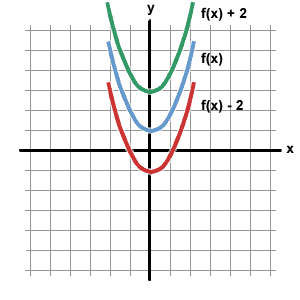Hey kidz!!! I am here to summarize and explain in english what we
learned so far.
Vocabularies :
Transformation - moving the function to a different
position keeping its original size, area and line length.
Translation-moving
the function in a different position without rotating or flipping.
Reflection- A transformation in which a geometric function is reflected across a line, creating a mirror image.
Reflection- A transformation in which a geometric function is reflected across a line, creating a mirror image.
I will tell you how the equation affects the function by showing
this formula:
y= Af(B (x+C))+D
A affects the "y -coordinate".
Multiply the "y value" to the value of A.(whatever the value is,use
it)
D affects the "y-coordinate". Add
or subtract the "y value" to the value of D.(whatever the value is, use
it)
B affects the "x-coordinate".
Multiply the "x value" to the reciprocal of B.(whatever the value is, get
its reciprocal and use it)
C affects the "x-coordinate". add
or subtract. the "x value" to the reciprocal of C.(if the value is positive,
add or subtract it with its negative value. vice versa )
-for Y multiply "A" first
then add/subtract D.(if
both are given)
-for X multiply B first then add/subtract C.(remember if C is positive,
make it negative. if C is negative make it
positive.)(if both are given)
Now I will show you how each of them affects the function by
giving examples:
1) y=f(x-2)
definition:function f(x)
was horizontally translated 2 units to the right.
English: the whole function was moved 2 units to the right.
2)y=f(x+2)
definition: function f(x)
was horizontally translated 2 units to the left.
English the whole function was moved 2 units to the left.
NB: if it's f(x-y), the graph will move to the right. if it's f(x+y), the graph will move to the right. opposite right? Deal with it.
3)y=f(x)-2
definition: function f(x)
was vertically translated 2 units down.
English: the whole function was moved 2 units down.
4)y=f(x)+2
definition: function f(x) was vertically translated 2 units up.
english: the whole function was moved 2 units up.


5) y=1/2 f(x)
definition: the function f(x) was vertically stretched by a factor of 1/2 about the x-axis.
English: the whole f(x) will open wider.
6) y=2f(x)
definition: the function f(x) was vertically stretched by a factor of 2 about the x-axis.
English:the whole function will open narrower.

7) y= f(2x)
definition: the function f(x) was horizontally stretched by a factor of 2 about the x-axis.
English:the whole function will open narrower.
8) y= f(1/2x)
definition: the function f(x) was horizontally stretched by a factor of 1/2 about the x-axis.
English:the whole function will open wider.

I hope I explained it to you very well in terms we can all understand. GG
definition: the function f(x) was vertically stretched by a factor of 1/2 about the x-axis.
English: the whole f(x) will open wider.
6) y=2f(x)
definition: the function f(x) was vertically stretched by a factor of 2 about the x-axis.
English:the whole function will open narrower.
7) y= f(2x)
definition: the function f(x) was horizontally stretched by a factor of 2 about the x-axis.
English:the whole function will open narrower.
8) y= f(1/2x)
definition: the function f(x) was horizontally stretched by a factor of 1/2 about the x-axis.
English:the whole function will open wider.
I hope I explained it to you very well in terms we can all understand. GG





